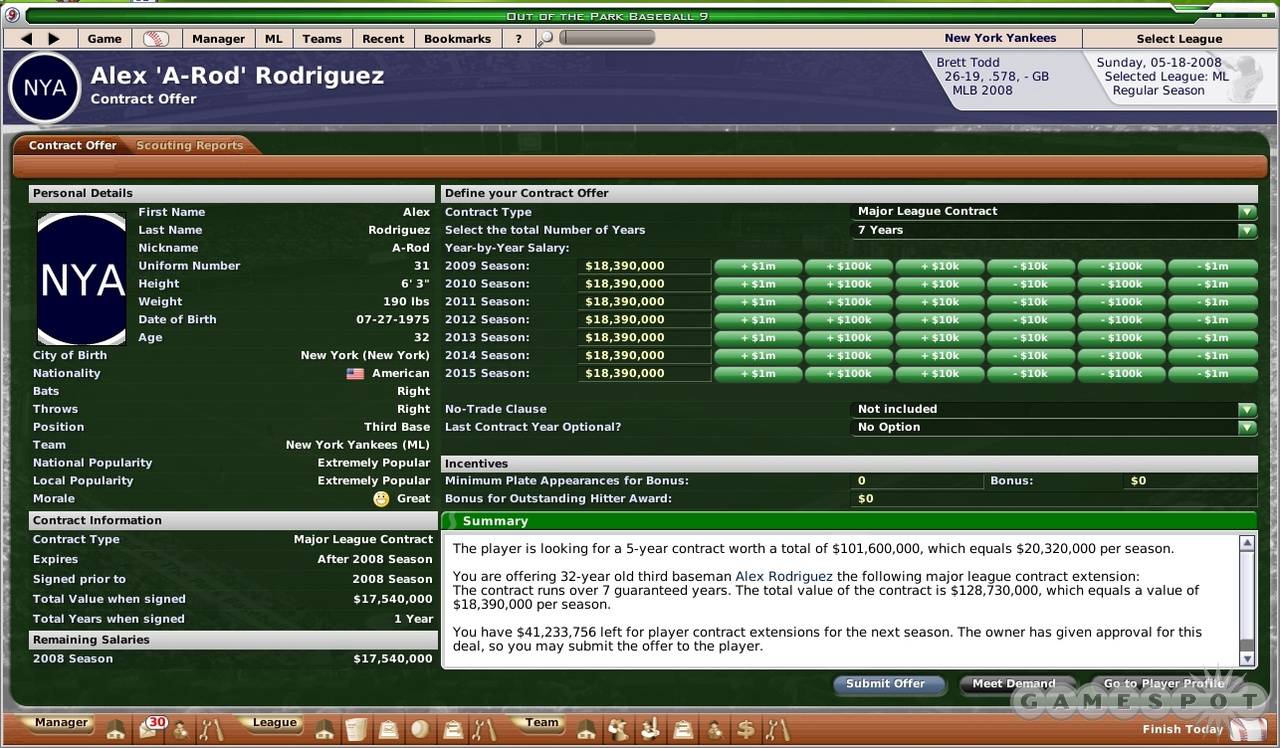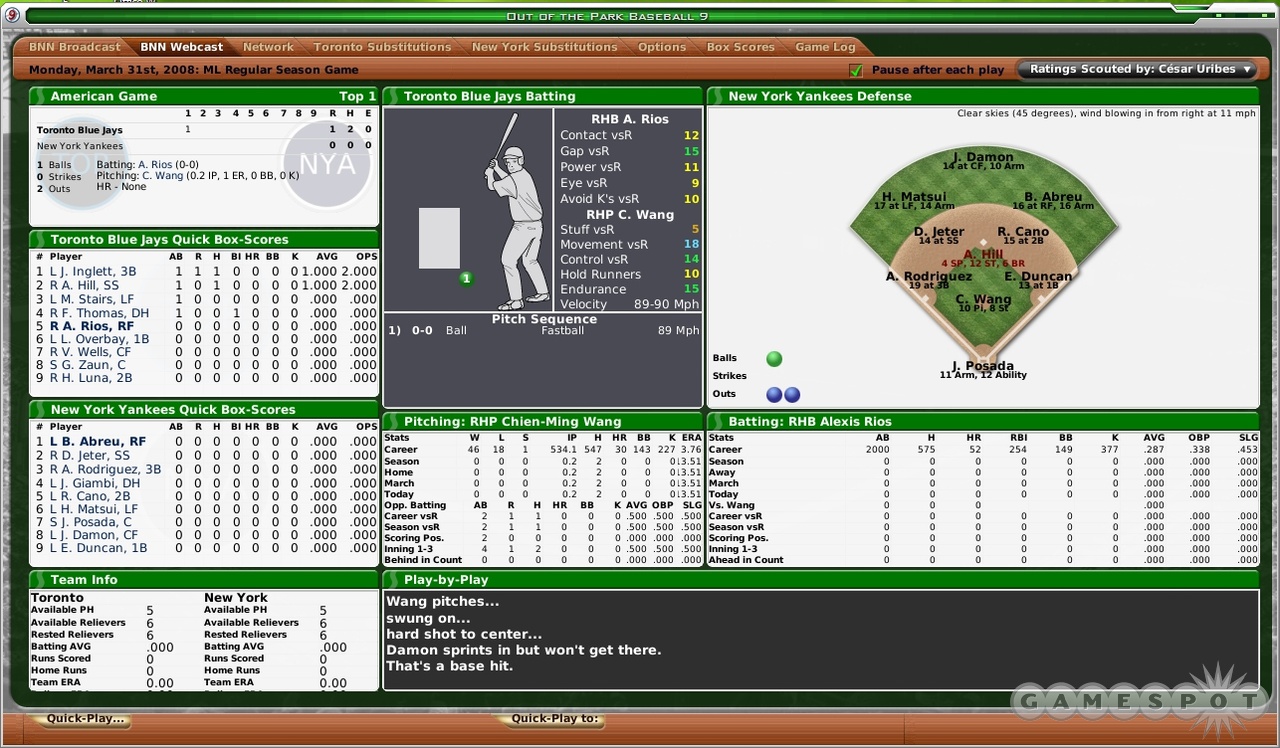For a game franchise in transition, Out of the Park Baseball 9 is incredibly well polished. The baseball management simulation series from one-man development team Markus Heinsohn may have just gone through a couple of tumultuous years due to being acquired and then dropped by the U.K. soccer-game masterminds at Sports Interactive, but you would never know it by the latest addition to the family. This edition of the game might just be the best yet, thanks to quicker sim times, the addition of major league players, and some small refinements that improve the interface. It remains a little too hardcore and stat-heavy for anyone who doesn't have aspirations to be the next Bill James, although the game is nearly perfect for bleacher creatures who have noggins for numbers.

Statisticphobes shouldn't be scared off, though. While you need an affinity for baseball stats to really appreciate the game, the core of the game is all about indulging your inner Steinbrenner and taking total control over the operations of a big-league baseball franchise. You oversee everything from the top down: signing free agents, trading clubhouse troublemakers out of town, inking stars to contract extensions, setting the daily lineups, organizing the starting pitching rotation/bullpen assignments, promoting/demoting players in the minors, and even deciding on an average ticket price. Seasons progress in a turn-based manner, and you can manually sim each game as the dugout bench boss, auto-sim one day at a time, or go for a big-picture approach by simming through whole weeks and months in big chunks. Leagues are just about unlimited in scope. You can play solo running one team, take over all the teams in Commissioner mode, or get into an online league to take on other Branch Rickey wannabes (the multiplayer support is outstanding). Historical database support and downloadable mods that add the entire major leagues from any point in their history let you start a baseball universe at any time from the formation of the National League in 1871 to present day. You can then continue for unlimited decades, moving through authentic league expansion, team movement, and whatever else baseball has grown through over the years.
Attention to detail is incredible, which results in an authentic major league baseball feel. Although the game is mostly text-based, with little visual pizzazz aside from player photos and the big-league ballpark depicted on the simulation screen, the atmosphere is so lifelike that you can almost hear the hotdog vendors. Dozens of stat categories are tracked for each player. So you better have a good idea what ERA, OPS, and WHIP stand for before making a challenge for the pennant. However, there is also a strong human element. Players are given role-playing-game-like ratings that involve such personality traits as mood, loyalty, leadership, greed, desire to play for a winner, and so on that affect on-field performance, as well as come into play whenever you talk contracts. Negotiations are about more than number-crunching because you often wind up with pouting wannabes demanding trades if they're riding the pine too often, happy superstars taking hometown discounts on contract extensions, and free agents who simply won't listen to your offers because they don't want to play for your organization. All of these preferences are communicated in plain old English, too, which makes it seem like you're dealing with real people--not just names and numbers. It might not seem like a big deal, but having A-Rod comment on your smooth negotiation skills while giving him a $120 million extension makes all the difference between playing virtual accounting with baseball stats and feeling like you're actually running a big-league franchise.
But with all that said, there isn't a whole lot in OOTP9 that is completely new. Although this is a more refined, more complete version of the game than its OOTP 2007 predecessor, it doesn't bring any showstopping new features to the table. Streamlining is really the big focus of the design. Gone is the cumbersome Sports Interactive scouting system with scouts all over the world, replaced by a single head scout who does everything. There's also an animated baseball on the game-sim screen so you can watch plays develop. The biggest improvement is probably the simulation speed, which has been dramatically ramped up across the board without any loss in realism. You can now rip through a full season in under half an hour of straight simming and even zip through a year in no more than a couple of hours as a more hands-on manager simming one week at a time. This is a huge plus when compared to the last two OOTP games and arguably worth the price of the new game all by itself. Only an occasional stutter remains to slow you down, such as the near eternity it takes to load up the player award voting screen at the end of a season.
Built-in major league rosters are the other top selling point because previous OOTP games only came with fictional players. Being able to send real contemporary MLB stars, such as Magglio Ordonez, Roy Halladay, and Derek Jeter, onto the diamond is a much more attractive option than having to deal with a bunch of anonymous Joe Sixpacks. But these rosters do need to be tweaked somewhat. Bizarrely poor performances from some of the best in the game are too common. In a year as the Yankees, for example, A-Rod hit just .243 and counted a measly 30 homers (his lowest since 1997), while 2007 19-game winner Chien-Ming Wang finished 6-10 with a 5.51 ERA. Most players are pretty much dead-on, although this quirkiness is pronounced enough to apparently produce some weird contracts. Bona fide big-money superstars sometimes settle for ridiculously low deals, while average Joes wind up making huge bucks. So the Yankees can cheap out when re-upping Hall of Fame closer Mariano Rivera for $3 million a year on a three-year pact (although maybe this was just a huge hometown discount for a longtime Yankee who didn't want to leave town), yet a light-hitting infielder like Chone Figgins somehow gets the Anaheim Angels to give him $10 million a season for three years.

Computer GMs will also lay down big money on past-it stars like Barry Bonds and Roger Clemens. In the first season we simmed, Bonds somehow got a three-year-deal worth $7.7 million a year from the Cincinnati Reds. Priorities seem to be skewed toward these established diamond dogs as well. While teams are making outrageous deals for washed-up old guys in their 40s, they're also dropping five-star prospects in their early 20s for no reason whatsoever. If you keep an eye on the waiver wire, you'll eventually scoop up enough talent to fill out a pitching staff. In our first season, the Yankees managed to put together the best middle relief in baseball due solely to a pair of killer young waiver pick-ups and score a 21-year-old four-and-a-half star starting pitcher who tore up AA ball.
At least the fictional and historical leagues aren't burdened with this sort of baggage. Starting with completely made-up rosters or going back to a past season seems to result in remarkably accurate player performances based on their skills and stats--whether you're playing on your own or in an online league. This is particularly noticeable if you go back to the 19th century--or the dead ball era--or even the offensively challenged years before the DH was introduced and the mound lowered. Now you can really see how different the game was back then, in terms of such key factors as greater pitcher endurance and fewer runs scored.
In a lot of ways, the above criticisms can be set aside as nitpicky. OOTP9 is a superb game--the closest thing we've got to major league baseball in a box. A few wrinkles need to be ironed out and owners of the previous game in the series might be a bit disappointed by the absence of prominent new features, but there is no doubt that this is the best baseball management sim out there for serious followers of the national pastime.